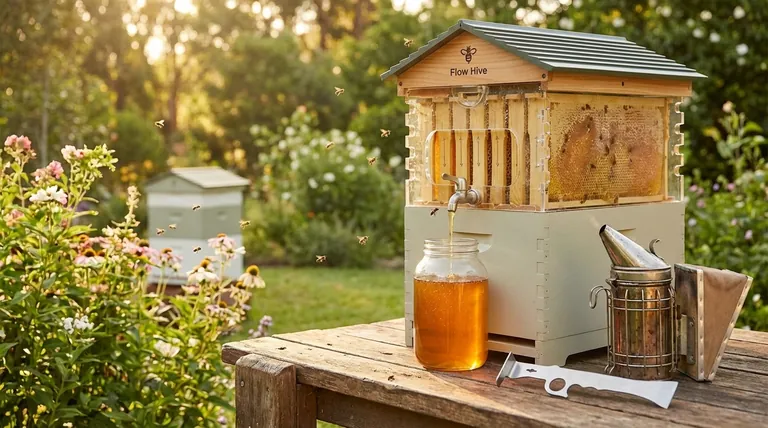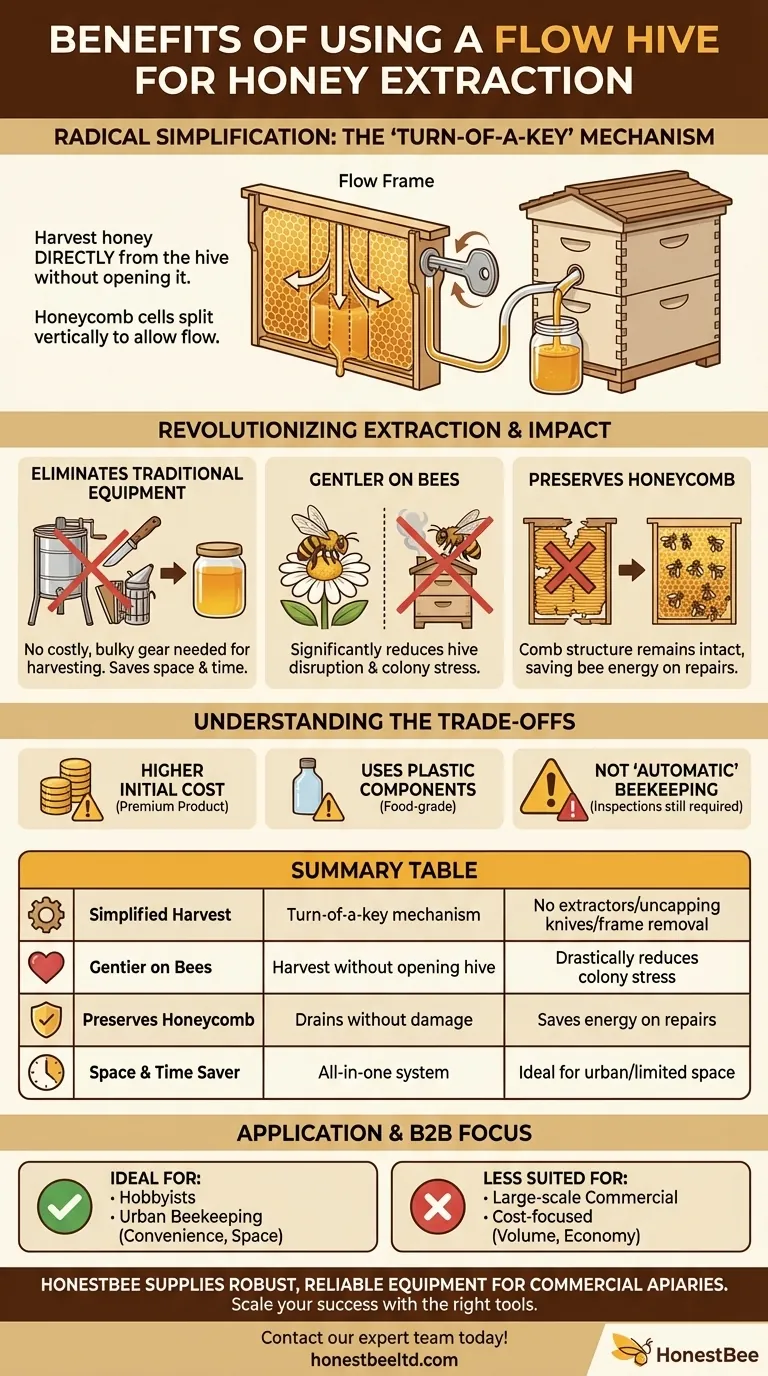The primary benefit of a Flow Hive is its radical simplification of the honey extraction process. It transforms a traditionally labor-intensive and disruptive task into a gentle, on-demand activity by allowing honey to be harvested directly from the hive without opening it, making it significantly less stressful for both the bees and the beekeeper.
A Flow Hive's core innovation is its specially designed frames that allow honey to be drained via a tap. This eliminates the need for expensive extraction equipment and the intrusive process of removing frames, making it an appealing, though costly, option for hobbyists who prioritize convenience and gentler bee management.

How Flow Hives Revolutionize Extraction
The value of the Flow Hive lies in how it completely redesigns the final, most demanding step of beekeeping: getting the honey out of the hive.
The "Turn-of-a-Key" Mechanism
Instead of removing frames, the beekeeper inserts a special tool, or "key," and turns it. This action vertically splits the partially formed honeycomb cells inside the frame.
This split creates channels, allowing the honey to flow downwards through the sealed frame and out a tube directly into your collection jar.
Eliminating Traditional Equipment
A traditional harvest requires a significant amount of gear, including a bee smoker, hive tools for prying frames, an uncapping knife, and a centrifugal extractor to spin the honey out.
The Flow Hive makes this equipment entirely redundant for the harvesting process, saving space, time, and a considerable upfront investment in extraction gear.
The Impact on Bee Health and Hive Stability
Beyond convenience for the human, the most profound benefits relate to the well-being of the honeybee colony itself.
A Gentler Process for the Bees
In a traditional harvest, the hive is opened, smoked, and frames are physically removed. This is a highly disruptive event that causes significant stress to the colony.
With a Flow Hive, the bees are left almost completely undisturbed. They can continue their work inside the hive while honey is quietly drained from the specific frames being harvested.
Preserving the Honeycomb
Traditional extraction requires the beekeeper to slice the wax cappings off the honeycomb. The spinning process in a centrifuge can also damage the delicate comb structure.
The Flow Hive mechanism leaves the wax comb structure intact. Once the honey is drained and the key is turned back, the bees only need to fill and re-cap the cells, saving them immense time and energy that would otherwise be spent on repairs.
Understanding the Trade-offs
While the benefits are clear, an objective assessment requires acknowledging the associated trade-offs. The Flow Hive is a specialized tool, not a universal solution.
The Significant Initial Cost
Flow Hives represent a premium product. The upfront cost for a complete hive or even just the specialized frames is substantially higher than for a standard Langstroth hive setup.
The Role of Plastic Components
The patented Flow Frames are made from food-grade plastic. While effective, some beekeepers prefer to use only natural materials like wood and beeswax inside their hives. This is a philosophical and practical consideration for purists.
Not a Replacement for Beekeeping Skills
A common misconception is that a Flow Hive is an "automatic" beekeeping solution. It only simplifies the extraction step.
Critical skills like regular hive inspections, pest and disease management, and ensuring colony health are just as necessary with a Flow Hive as with any other.
How to Apply This to Your Goal
Your decision to use a Flow Hive should be based on your specific priorities as a beekeeper.
- If your primary focus is convenience and a less invasive hobby experience: The Flow Hive is an excellent choice, as it removes the biggest physical and equipment hurdles of honey harvesting.
- If your primary focus is urban beekeeping with limited space: The Flow Hive's clean, all-in-one extraction process makes it uniquely suited for small backyards where messy equipment is not practical.
- If your primary focus is cost-effectiveness or producing honey on a larger scale: Traditional hive setups and extraction methods remain the more economical and proven solution.
Ultimately, the Flow Hive excels at making the rewarding experience of honey harvesting more accessible, gentle, and enjoyable.
Summary Table:
| Benefit | Key Feature | Impact |
|---|---|---|
| Simplified Harvest | Turn-of-a-key mechanism | No need for extractors, uncapping knives, or removing frames |
| Gentler on Bees | Harvest without opening the hive | Drastically reduces colony stress and disruption |
| Preserves Honeycomb | Drains honey without damaging comb | Saves bees energy on repairs and re-capping |
| Space & Time Saver | All-in-one system | Ideal for urban beekeepers with limited space |
Ready to simplify your beekeeping operation? The Flow Hive is a game-changer for hobbyists, but running a commercial apiary requires robust, reliable equipment. HONESTBEE supplies durable beekeeping supplies and equipment to commercial apiaries and distributors through our wholesale-focused operations. Let us help you scale your success with the right tools. Contact our expert team today to discuss your needs!
Visual Guide

Related Products
- HONESTBEE Advanced Ergonomic Stainless Steel Hive Tool for Beekeeping
- Professional Dual-End Stainless Steel Hive Tool for Beekeeping
- Professional 3-Bar Frame Grip with Integrated Hive Tool
- HONESTBEE 72 Frame Industrial Electric Honey Extractor for Beekeeping
- Beehive Handle and Frame Rest Cutting Machine: Your Specialized Hive Machine
People Also Ask
- What are the basic tools for beekeeping? Essential Starter Kit for Safe & Successful Hive Management
- What are the features of a regular hive tool? The Essential Multi-Tool for Every Beekeeper
- What tools are used for cleaning frames? A Beekeeper's Simple 4-Tool Guide
- What are some common uses of a hive tool? Essential Multi-Purpose Tool for Every Beekeeper
- How should beekeepers handle bees when using a hive tool? Master Calm, Deliberate Techniques



















